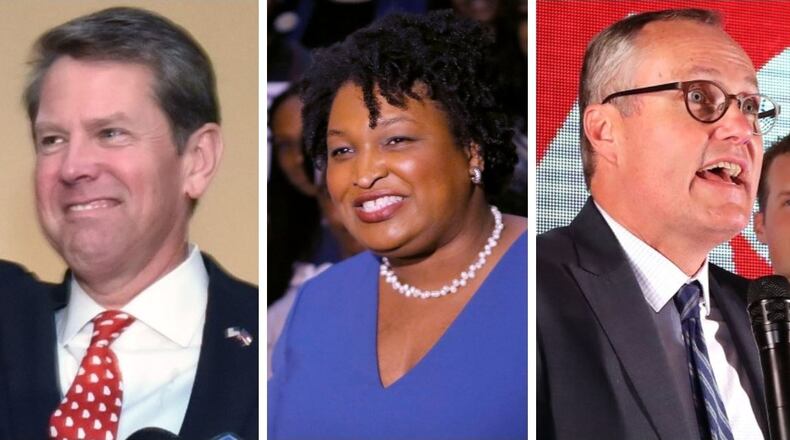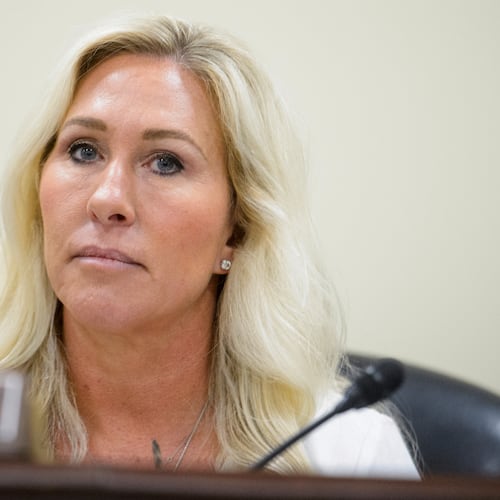The race for governor has fast become the costliest contest for the state’s top job in Georgia history.
New financial reports released this week show the candidates in the hunt to succeed Gov. Nathan Deal have raised or loaned themselves roughly $33 million.
That figure is only set to grow: There’s still four months to go in the race.
The documents reinforce trends that have long shaped the race. Lt. Gov. Casey Cagle is still the campaign cash king. Secretary of State Brian Kemp, who faces Cagle in the July 24 GOP runoff, is holding his own. And Democrat Stacey Abrams is taking advantage of the Republican tiff to restock her coffers.
The reports, which cover a three-month period from April 1 through June 30, also offer a glimpse of the late — and ultimately futile — maneuvering by the five also-rans in the race.
For instance, former state Rep. Stacey Evans donated an additional $500,000 of her own cash to her campaign in the final stretch — bringing her total personal investment to roughly $2 million — only to be trounced by Abrams in her party’s primary.
The fundraising has shattered Georgia spending records. The costly Democratic runoff in 2006 between Cathy Cox and Mark Taylor for the right to face Gov. Sonny Perdue pushed the overall cost of that governor’s race to roughly $30 million, a high bar matched by the crowded 2010 frenzy won by Deal.
But this contest, which featured two Democrats and five Republicans each with seven-figure takes, seems destined to make those races appear quaint by comparison.
Cagle has already raised more than $10.5 million, and he remains the overwhelming favorite of the well-connected lobbyists and business interests who have poured hundreds of thousands of dollars into his campaign.
Kemp has struggled to keep pace with his rival, with a $4.5 million overall take. But that’s enough cash to fuel a surge of late advertisements, and Kemp’s campaign has reserved about $1 million worth of airtime for the final stretch.
And Abrams has worked to raise her profile — and plenty of cash — since her primary win. She’s raised $6 million overall — and roughly $2.75 million this period — much of it from out-of-state donors. With $1.5 million in cash on hand, she has more money in her campaign coffers than either GOP candidate, and no need to spend any of it on a runoff.
That's not counting money pouring into the race from third-party groups who aren't allowed to coordinate with the candidates. A San Francisco-based activist group has pledged to pump in more than $10 million to help elect Abrams by mobilizing left-leaning residents who aren't registered to vote.
And several pro-Cagle boosters have built accounts bursting with cash. One group, called Changing Georgia's Future, reported this week that it has raised more than $1 million. Two other funds created under federal tax law have collected at least $2 million to support Cagle's campaign.
What does it mean for you? Well, the tide of cash assures even more spending on flyers to fill mailboxes and clog doorsteps, ads that flood the airwaves and fill websites and mobile phones, and expanded field staffs to knock on doors and organize rallies.
Mega-donors
Cagle, who is hampered by a secretly taped conversation with a vanquished opponent, has long had a dominating fundraising edge. And his most recent contributions showed that's not likely to change.
The Capitol crowd stalwarts who have showered him with donations since he entered the race last year have intensified their support, and an Atlanta Journal-Constitution analysis shows lobbyists and special-interest political action committees chipped in more than $290,000 to Cagle's campaign over the past three months.
That included donations from the state’s dominant banking, dental, hotel and liquor distribution associations, the new-car dealer’s lobby and the National Rifle Association’s political arm.
The $290,000 does not include state vendors and other businesses that rely on state funding. One Middle Georgia family that runs nursing homes gave about $45,000 in the past three months. Nursing homes receive more than a $1 billion in state funding each year.
Famous businessmen, such as Republican mega-donor Bernie Marcus, also gave to Cagle.
Kemp, has relied far less on the statehouse crowd, taking in most of his money from Georgia businesses and individuals.
He has, however, faced questions about whether he accepted improper donations from donors who work in fields his office regulates. And the latest reports showed he continued to take contributions from electricians, contractors and others under his oversight.
He also was helped by a string of high-profile donors that include former U.S. Rep. Bob Barr, Novare Group Chief Executive Jim Borders and several Republican state legislators.
Abrams had a strong showing with donors big and small, collecting thousands of small contributions from across the country. She also benefited from nearly $100,000 in big contributions from political action committees and labor, such as Planned Parenthood and the national bricklayers union.
The Abrams campaign said it received money from more than 31,000 donors during the reporting period, with half of the contributions being under $25.
2018 campaign
The Atlanta Journal-Constitution is covering the issues and candidates in a busy election year. Previous stories have focused on topics such as gun rights, immigration and tax policy. Look for more at PoliticallyGeorgia.com as the state approaches the next political milepost, the July 24 Republican runoff for governor.
Keep Reading
The Latest
Featured





